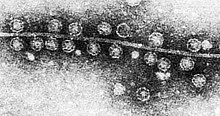Bacteriophage Qbeta
| Bacteriophage Qbeta | |
|---|---|

| |
| Virus classification | |
| Group: | Group IV ((+)ssRNA)
|
| Family: | |
| Genus: | |
| Species: | Bacteriophage Qβ
|
Bacteriophage Qβ is an icosahedral virus with a diameter of 25 nm. Its host is Escherichia coli. Qβ enters its host cell after binding to the side of the F pilus.[1]
Genetics
The genome of Qβ is 4215 nucleotides long. The genome has three open reading frames and encodes four proteins: A1, A2, CP and qβ replicase. The genome is highly structured, which regulates gene expression and protects the genome from host RNases.[1]
Protein A2
A2 is called the maturation protein due to its lysis activity. One copy of A2 is present per virion. The mechanism of lysis is similar to that of penicillin; A2 inhibits the formation of peptidoglycan by inhibiting the enzyme UDP-N-acetylglucosamine 1-carboxyvinyltransferase (MurA), which catalyzes the first committed step of peptidoglycan synthesis.
A2 also functions in host cell recognition and cell entry. When A2 binds to the sex pilus of the bacterium, A2 cleaves and forms a pore into the host.
RNA Polymerase
The RNA polymerase that replicates both the plus and minus RNA strands is a complex of four proteins: the beta subunit (replicase) is encoded by the phage, while the other three subunits are encoded by the bacterial genome: alpha subunit (ribosomal protein S1), gamma subunit (EF-Tu), and delta subunit (EF-Ts).[2]
Experiments
RNA from Bacteriophage Qβ was used by Sol Spiegelman in experiments that favored faster replication, and thus shorter strands of RNA. He ended up with Spiegelman's Monster, an RNA chain of only 218 nucleotides that is also self-replicating.
References
- ^ a b Kashiwagi A, Yomo T (August 2011). "Ongoing phenotypic and genomic changes in experimental coevolution of RNA bacteriophage Qβ and Escherichia coli". PLoS Genetics. 7 (8): e1002188. doi:10.1371/journal.pgen.1002188. PMC 3150450. PMID 21829387.
{{cite journal}}: CS1 maint: unflagged free DOI (link) - ^ van Duin, J.; Tsareva, N. (2006). "Single-stranded RNA phages. Chapter 15". In Calendar, R. L. (ed.). The Bacteriophages (Second ed.). Oxford University Press. pp. 175–196. ISBN 0195148509.
